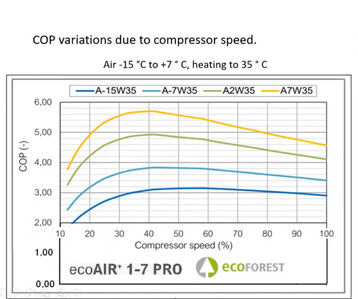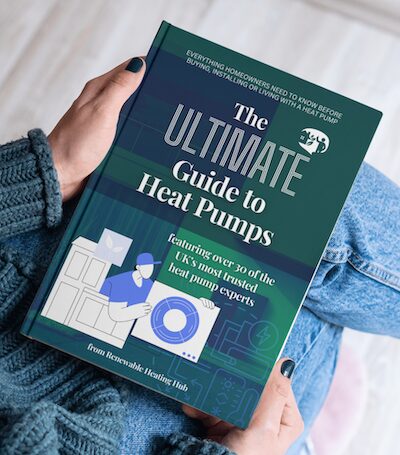Sounds like your 6kW unit is really just an 8kW with a software cap. If it holds steady output across temps while the 8kW drops off, that’s a clear sign. Just shows how misleading the kW labels can be.
Notifications
Clear all
Is Your 6kW Air Source Heat Pump Really a 6kW?
Topic starter
08/05/2025 12:21 pm
Most domestic heat pumps sold in the UK are categorised by a kilowatt (kW) rating, often 5kW, 6kW, 8kW or similar. But these figures are widely misunderstood. They are not guaranteed outputs in all conditions. In fact, the stated output is often only achievable under specific test parameters: generally, an outdoor air temperature (OAT) of 7C and a flow temperature of 35C. These conditions are rarely representative of winter heating demand in the UK.
At lower outdoor temperatures, heat pumps lose capacity. A 6kW unit that achieves its full output at 7C may struggle to deliver even 4.5kW at -3C. This drop in output has direct implications for performance. If a heat pump has been sized based on its nominal rating without properly accounting for low ambient temperature performance, the system may be unable to meet the heating demand in colder weather. In such cases, the shortfall is often incorrectly blamed on the technology, rather than the system design or sizing.
Adding to the confusion is the practice among some manufacturers of using the same physical hardware across multiple model ratings. A 5kW and 8kW unit may be mechanically identical, with the only difference being software configuration. This means that a so-called 5kW unit may, under certain conditions, deliver more than 5kW, and an 8kW may struggle to meet that figure consistently in real-world scenarios.
These issues are compounded by changes to how performance estimates are now calculated. Earlier this year, MCS implemented a new standard (MCS 031) that replaces manufacturer-declared SCOP (Seasonal Coefficient of Performance) values with standardised Seasonal Performance Factors (SPFs). These SPFs are fixed for all heat pumps based on flow temperature bands, regardless of the specific unit’s capabilities:
- <35C: SPF 4.0
- 36–40C: SPF 3.8
- 41–45C: SPF 3.4
- 46–50C: SPF 3.1
- 51–55C: SPF 2.8
- 56–65C: SPF 2.5
This approach removes variation between manufacturers and is intended to simplify performance estimates. However, it also masks differences between systems, particularly at higher flow temperatures. For installers and consumers, this creates a massive challenge: the published SPF no longer reflects the real performance potential of a better-designed or higher-specification heat pump.
The core problem remains: the industry lacks clear and consistent communication about how heat pumps perform across the full range of outdoor temperatures. Most consumers (and many installers) still interpret nominal figures as guarantees. In reality, they are conditional benchmarks. The impact of poor sizing is often not seen until outdoor temperatures drop below design conditions, which in the UK typically range from -1C to -3C.
The result is predictable: underperformance, increased use of immersion heaters or backup sources, and customer dissatisfaction. These outcomes are preventable. Correct sizing, based on detailed room-by-room heat loss calculations and accurate climate data, remains essential. Equally, manufacturers and certification bodies must do more to improve transparency around performance data, particularly at low ambient conditions and higher flow temperatures.
Until then, it is likely that homeowners will continue to be misled by kW labels that are, at best, incomplete, and at worst, materially misleading. Why does Brand X’s 8kW unit perform like Brand Y’s 5kW? The lack of standardisation feels intentional, and it’s no wonder so many systems end up undersized, oversized or wasteful. This confusion must end.
This topic was modified 8 months ago 2 times by Mars
Get a copy of The Ultimate Guide to Heat Pumps
Subscribe and follow our YouTube channel!
Quote
Topic Tags
My heat pump is a sold as a 6kW. But it does almost the same kW at any flow temp and any outside temp varies between 5.88 (-15) and 7kW (+30).
So strongly suspect it's really an 8kW with a software gag on output. The 4kW is pretty similar almost flat output of 4kW, but the 8kW output varies by quite a margin, with -15 performance pretty similar to the 6kW unit, at just over 6kW.
👍
2
ReplyQuote
Posted by: @editorUntil then, it is likely that homeowners will continue to be misled by kW labels that are, at best, incomplete, and at worst, materially misleading. Why does Brand X’s 8kW unit perform like Brand Y’s 5kW? The lack of standardisation feels intentional, and it’s no wonder so many systems end up undersized, oversized or wasteful. This confusion must end.
In fairness to heat pump manufacturers the output inevitably (unless artificially restricted in software) varies with oat and FT. Furthermore the variation is different between manufacturers and models, depending on compressor characteristics and how they have chosen to tune performance.
There is no way that a single figure can describe this complexity and thus it is unrealistic to expect all models branded as having similar 'headline' outputs to have the same output under all relevant conditions. So we either have to dispense altogether with headline figures or accept that they tell only a small part of the story.
To add to the challenge, design outdoor temperatures, even within one country eg UK, vary quite significantly so a 7kW unit in Glasgow may be good for 8kW in Plymouth and probably 5kW in Prague.
For me the current approach of specifying 'headline' output at a given set of conditions is a practical one, and in reality probably the only practical one. One might reasonably argue that the specified condition should be at a lower oat than 7C. I don't know where that figure came from, presumably it's an EU standard, but if so it's a bit odd because there can't be many parts of the EU where this would be a sensible design temperature.
What I do think is missing, however, is the detailed design tables specifying max and min output as a function of ft and oat (including the effect of defrost) Some manufacturers are very good at this (eg Mitsubishi which publishes very comprehensive data), some mediocre (eg Vaillant which does publish detailed tables but only in Czech on its Czech website, and says nothing about defrost) and some dreadful (eg Daikin which hides most of the data unless you are an installer, and Samsung which seems to publish very little also). My view us that the open publication of this detailed data should be mandatory and if it were there would be no excuse for designers to get it wrong.
This post was modified 8 months ago by JamesPa
4kW peak of solar PV since 2011; EV and a 1930s house which has been partially renovated to improve its efficiency. 7kW Vaillant heat pump.
👍
1
ReplyQuote
Posted by: @jamespaWhat I do think is missing, however, is the detailed design tables specifying max and min output as a function of ft and oat (including the effect of defrost)
Think you can find the data, if willing to search, but it should be freely available to anyone, it's not exactly that much data. 1 table says it all, or 2 tables to include cooling.
A lot of heat pumps are just name badge engineering, the issue is the company willing to slap a badge on someone else product, is just playing, not really that involves or really that bothered.
Our heat pump is a Maxa, they are the actual manufacturer, was and still is badge engineered by many big companies including Viessmann.
👍
1
ReplyQuote
Posted by: @AnonymousWhat I do think is missing, however, is the detailed design tables specifying max and min output as a function of ft and oat (including the effect of defrost)
Think you can find the data, if willing to search, but it should be freely available to anyone, it's not exactly that much data. 1 table says it all, or 2 tables to include cooling.
That's my point really, it should be both freely and readily available. As you say it's just a table (or set of graphs) of cop and output vs ft and oat at max and min modulation frequency, and maybe a couple of intermediate frequencies for good measure. Mitsubishi can manage that, why not everyone?
This post was modified 8 months ago 3 times by JamesPa
4kW peak of solar PV since 2011; EV and a 1930s house which has been partially renovated to improve its efficiency. 7kW Vaillant heat pump.
💥
1
ReplyQuote
ReplyQuote
This output rating is very much of interest since a digitally altered HP may possess all the limitations of the higher output model such as minimum output operation. I believe this may be the case for the 6kw Mitsubishi which has similar lower output limit of the 8.5kw model.
another reason for knowing the true design output is relevant since it would appear that most of not all HPs appear to be operating at their best COP when operating at 40% level of output, with poorer COPs above and below that level. So how does anybody target their best output/efficiency level?
So the question becomes - 40% of what?
(info courtesy of @jamespa post of the John Cantor cop chart)
This post was modified 8 months ago by SUNandAIR
ReplyQuote
Posted by: @sunandairbest COP when operating at 40% level of output
There are various ways to look at things related to CoP. Best CoP doesn't always mean the lowest running cost. Things like PV generation, time of use tariff all play a part.
I encourage mine to run at 33 to 35 degrees (WC setting starts at 27 degs), when I have decent battery charge and producing from PV, via a double set point volt free contact. So effectively get a cop of 4 to 5 while running. During this period it's also playing catch-up trying to heat a big slab of concrete, so runs at full load, does not stop running for an hour or two or more. In shoulder months I can nearly heat the house for free, but daily CoP is about 3, because I leave the circulation pump on 24/7 to balance the heat around the house. But best part of zero cost, so not really caring.
WC when set up the heat pump isn't playing catch up, so by default will firstly try to establish return temperature while maintaining dT, then will modulate to maintain a fixed or variable dT, depending on heat pump. Trying to achieve best efficiency point.
I wouldn't try to overthink it, are you on a time of use tariff, run hotter during these periods if you can or charge battery if you have one or both. Not on time of use run 24/7 on WC.
I am currently cooling,.but run that on almost straight WC with a 1 Deg boost setting when there is excess solar, otherwise I run could into condensation issues.
ReplyQuote
@johnmo
I think we’ve been trudging through the same black hole of heat pumps for roughly the same time.
My post above wasn’t really about user tactics for settings, as you have kindly offered, although your combination of tariffs etc looks like it works well.
My comments above are really aimed at the manufacturers role in providing useful product performance data so any or all homeowners and users can make informed decisions about how to set up and get the best out of their HP.
It is continually surprising to me that so many pitfalls from design, pipework, buffers or cycling seem to still exist around installing and operating a heat pump, when it should be seen as a trouble free transition. This must put a slur on the image of heat pumps at a time when the image should be bright and optimistic.
So in the above case the fact that HPs have a peak efficiency at a certain modulation which may be higher than the minimum output would be useful to know when anyone wants to set up a WCcurve.
Yet it’s not conveniently catalogued by most manufacturers in a format for homeowners literature so they can make use of it.
here is the chart from John cantors video on cycling which shows varying efficiency at different percentage outputs which I think is helpful.
On a personal level I think we’ve got ours set up as good as we can without making material changes since it’s an old house with an all radiator setup. We are also using thermal solar for water at this time of year but we don’t have PV as yet.
This post was modified 8 months ago by SUNandAIR
ReplyQuote
Forum Jump:
Related Topics
-
Oversized Daikin 9kw
9 months ago
-
Is your gut better than Math
9 months ago
-
Undersized ASHPs & Unbelievable energy bills
4 years ago
Forum Information
- 26 Forums
- 2,367 Topics
- 53.7 K Posts
- 269 Online
- 6,042 Members
Our newest member: jet4o
Latest Post: ASHP sizing - value of Heat Transfer Coefficient
Forum Icons:
Forum contains no unread posts
Forum contains unread posts
Topic Icons:
Not Replied
Replied
Active
Hot
Sticky
Unapproved
Solved
Private
Closed
Join Us!
Worth Watching
Latest Posts
-

-
RE: Testing new controls/monitoring for Midea Clone ASHP
@cathoderay Newer manuals display this however:
By Tasos , 14 minutes ago
-

RE: Forum updates, announcements & issues
As we head into 2026, I just wanted to take a moment to...
By Mars , 2 hours ago
-

RE: Setback savings - fact or fiction?
I agree, and I think there are two things in play here....
By cathodeRay , 3 hours ago
-
RE: Changing from 4-port buffer to volumizer
Thank you so much for your help. After New Years I'll g...
By Andy1618 , 6 hours ago
-
RE: Water Hammer After Heat Pump Install
That's really helpful. Yor last sentence confirms it'...
By JamesPa , 8 hours ago
-

RE: Connecting Growatt SPH5000 over wired ethernet rather than wireless
Having had another little look around, it seems Growatt...
By Majordennisbloodnok , 9 hours ago
-
Data Accuracy Problem: Daikin 8kW Heat Pump's Onecta App vs MMI Power Consumption
Good Evening. Has anyone found the following when usi...
By Nursethescreens , 22 hours ago
-
RE: Help needed with Grant Aerona 3 issues
First time posting so bear with me. Some bits that have...
By Adamp , 1 day ago
-
RE: Mitsu PUHZ-SW120YHA + EHSC-VM20Uk - Performance
All understood. Obviously its a bit house de...
By JamesPa , 1 day ago
-
RE: Who's your electricity provider and what's your tariff?
@majordennisbloodnok This may be a better thread to ...
By Batpred , 2 days ago
-

RE: Best Heat Pump Brand in the UK
Last Call to Vote & Win! Haven't voted for your Hea...
By Mars , 2 days ago
-

RE: Solis S6-EH1P8K-L-PLUS – Why I Chose It and What I’ve Learned So Far
Interesting question. To be frank, since I have no inte...
By Majordennisbloodnok , 2 days ago
-
RE: New Fogstar 15.5kWh upright solution
The video shows the JK balancer, but the connection of ...
By Batpred , 3 days ago
-
RE: Ecodan unable to hit legionella target temp - what's the consensus?
@9jwr9 Hi, yes this is the issue with every (stand alon...
By ASHP-BOBBA , 3 days ago
-
RE: Help me keep the faith with my air source heat pump installation
@adamk FWIW I managed unintentionally to 'coax' mine in...
By JamesPa , 3 days ago
-
RE: Octopus Cosy Heat Pump Owners & Discussion Thread
You are in essence right. Adia only works with selecte...
By JamesPa , 3 days ago
-

No, you haven’t missed out, @batpred. This thread’ll st...
By Majordennisbloodnok , 3 days ago
-

RE: Tesla Powerwall – More of a ‘Luxury’ Than an ROI Winner!
Also, though they weren’t prepared to match the price t...
By Toodles , 3 days ago







